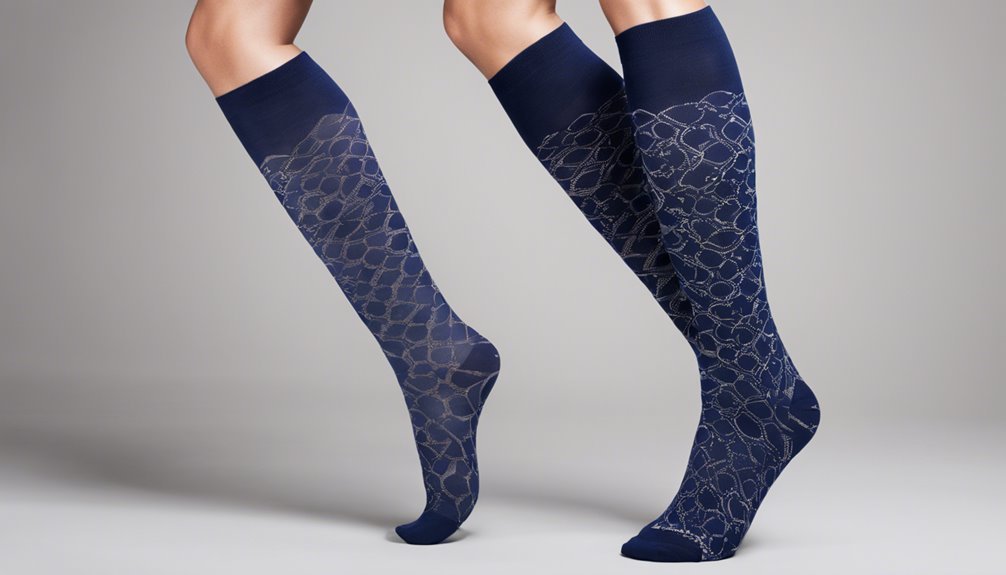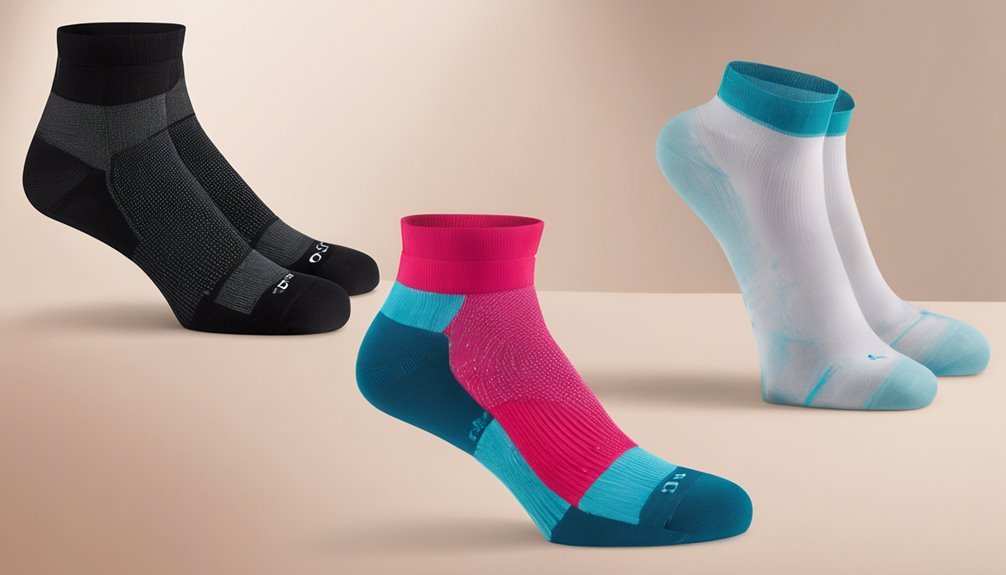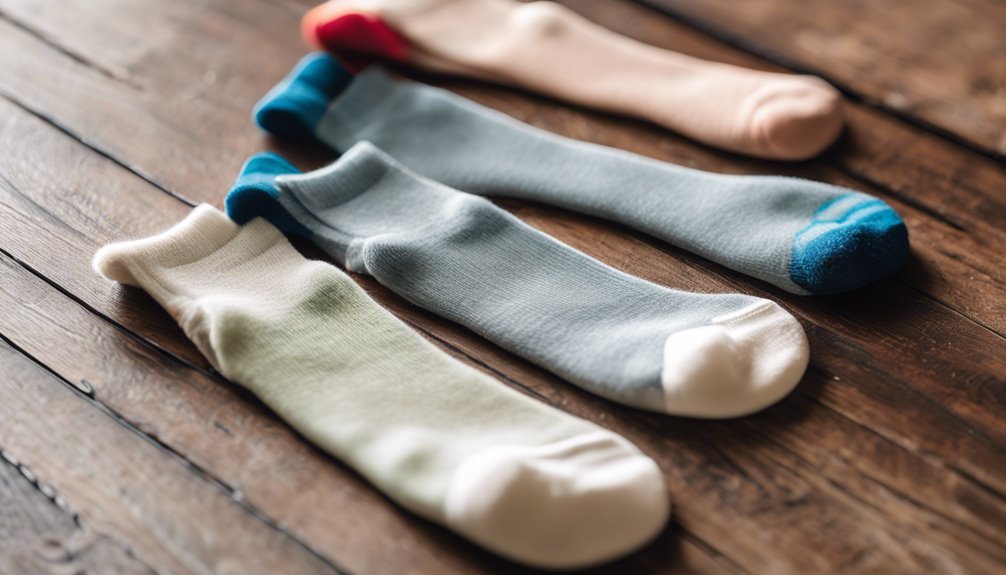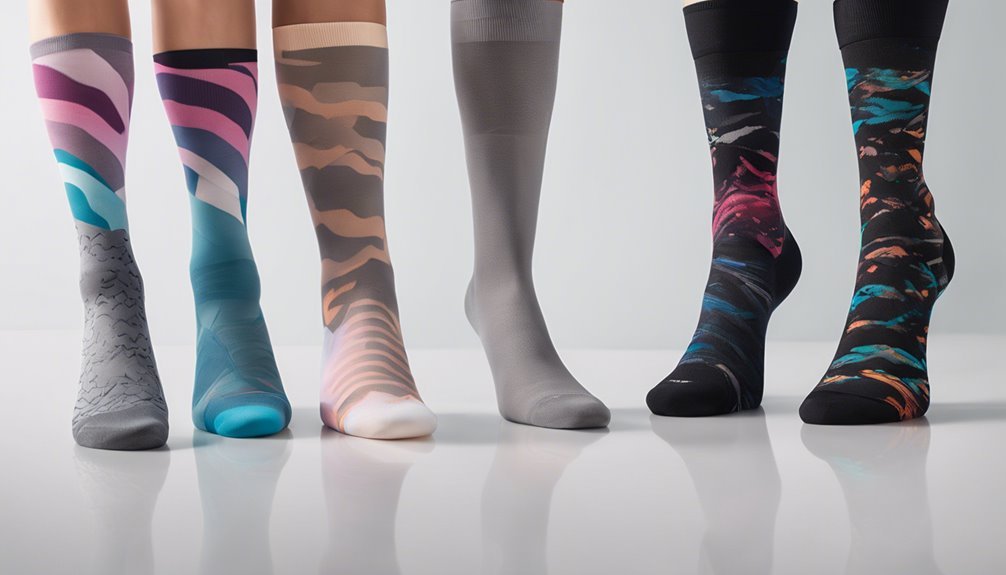Medical-Grade Compression Socks vs. Regular Compression Socks: Are They Worth It?
Medical-grade compression socks are designed for specific therapeutic benefits, offering higher compression levels for conditions like varicose veins and post-surgery recovery. Regular compression socks provide general support and comfort for everyday activities. If you're looking for targeted relief or have health conditions, medical-grade options might be worth the investment. However, if you need mild support for travel or light exercise, regular socks could suffice. Explore more about how to choose the right type for your needs.
Understanding Compression Socks: An Overview

When you think about compression socks, it's important to understand their purpose and function. These specialized garments come in various compression sock types, each designed to support specific needs. Graduated compression socks apply varying levels of pressure, promoting better circulation in the legs. You might find knee-high, thigh-high, or even full-length options, catering to different preferences and requirements.
The compression sock benefits are numerous, including reduced swelling, increased blood flow, and prevention of venous issues. They're particularly favored by athletes for enhanced performance and quicker recovery. Whether you're looking for relief during long flights or support during workouts, understanding the available types helps you make informed choices, ultimately granting you the freedom to engage in your activities with greater comfort and confidence.
The Importance of Compression Levels
Understanding the importance of compression levels is crucial for selecting the right compression socks for your needs. Different compression levels provide varying pressure gradients, which can greatly impact your comfort and health.
| Compression Level | Pressure Gradient (mmHg) | Ideal Use |
|---|---|---|
| Mild | 8-15 | Everyday wear |
| Moderate | 15-20 | Travel and light exercise |
| Firm | 20-30 | Recovery and varicose veins |
| Extra Firm | 30-40 | Severe swelling and edema |
Choosing the correct level guarantees ideal blood flow, reduces swelling, and promotes overall leg health. So, consider your specific needs and consult a healthcare professional if you're unsure which level suits you best.
Medical-Grade Compression Socks: What You Need to Know
Medical-grade compression socks are designed to provide specific compression levels for therapeutic purposes. They're commonly used to manage conditions like varicose veins, edema, and post-surgical recovery. Understanding their definition and medical benefits can help you make informed choices about your leg health.
Definition and Purpose
Compression socks are specialized garments designed to promote better blood circulation in the legs. They work by applying graduated pressure, which helps veins efficiently pump blood back to the heart. There are various compression sock types, including medical-grade and non-medical options, each tailored to specific needs. Medical-grade compression socks typically have higher compression levels and are often prescribed for individuals with circulatory issues. Regular compression socks, while helpful for general comfort, may not provide the same level of circulation improvement. When choosing the right type, consider your lifestyle, activity level, and any medical conditions. Understanding these differences can help you make an informed decision about which compression socks best suit your needs for ideal leg health.
Medical Uses and Benefits
For those dealing with specific health issues, medical-grade compression socks offer significant benefits. These socks are designed to deliver graduated pressure, promoting better venous health and aiding circulation improvement. If you suffer from conditions like chronic venous insufficiency, varicose veins, or deep vein thrombosis, wearing these socks can help alleviate symptoms and prevent complications. They work by squeezing your legs, which helps blood flow back to the heart, reducing swelling and discomfort. You'll find that wearing medical-grade compression socks can enhance your overall well-being, especially during long periods of standing or sitting. While they may feel snug, the freedom they provide from pain and fatigue is worth it for many individuals seeking relief and improved mobility.
Regular Compression Socks: Features and Benefits
Regular compression socks come in various compression levels, catering to different needs and preferences. You'll find that comfort and fit are essential for daily wear, making them suitable for a range of activities, from work to exercise. Understanding these features can help you choose the right pair for your lifestyle.
Compression Levels Explained
While choosing the right compression socks, understanding the varying levels of compression is essential for ideal support. Compression levels are typically measured in millimeters of mercury (mmHg) and indicate the amount of pressure applied to your legs. Regular compression socks generally range from 8-15 mmHg for mild support to 15-20 mmHg for moderate support. These pressure gradients create a beneficial effect, promoting better blood circulation and reducing swelling. The higher the compression level, the greater the pressure applied, which can help prevent conditions like varicose veins and deep vein thrombosis. By selecting the right compression level, you can enjoy increased comfort and enhanced performance, ensuring your legs feel energized throughout the day.
Comfort and Fit
When searching for compression socks, comfort and fit are essential factors that can greatly impact your wearing experience. Regular compression socks offer several features and benefits that enhance your comfort:
- Breathability Factors: Look for materials that promote airflow, keeping your feet dry and comfortable.
- Fit Adjustments: Many brands provide various sizes and styles to guarantee a snug fit tailored to your needs.
- Cushioning: Some options include extra padding in key areas to reduce discomfort during prolonged wear.
- Seamless Design: A smooth construction minimizes irritation, allowing for all-day use without chafing.
Everyday Use Cases
Comfort and fit greatly influence how often you'll wear compression socks, making it important to evaluate their practical applications. Regular compression socks offer notable benefits for everyday activities. If you're an athlete, these socks can enhance athletic performance by promoting better blood circulation, reducing muscle fatigue, and aiding recovery post-exercise. For frequent travelers, they provide essential travel comfort by preventing swelling and discomfort during long flights or drives. Additionally, they can help reduce the risk of developing varicose veins, making them a smart choice for those who stand or sit for extended periods. With various styles and colors available, you can easily incorporate them into your daily wardrobe while enjoying the benefits they bring to your overall well-being.
Key Differences in Materials and Design

The distinction between medical-grade and regular compression socks lies significantly in their materials and design. Medical-grade socks often feature advanced material durability, ensuring they withstand frequent use while maintaining compression levels. In contrast, regular socks may prioritize comfort over performance, lacking the same level of support.
Here are key differences:
- Material Composition: Medical-grade often uses stronger, breathable fabrics.
- Compression Levels: Medical-grade provides higher, more specific compression.
- Design Innovation: Medical options include ergonomic designs tailored for therapeutic benefits.
- Certifications: Medical-grade socks usually come with regulatory approvals, ensuring effectiveness.
Understanding these differences helps you choose the right sock for your needs, balancing comfort and support effectively.
Intended Uses: Medical vs. Everyday Wear
Choosing the right compression sock also depends on its intended use. Medical-grade compression socks provide specific therapeutic applications, often prescribed for conditions like varicose veins or post-surgery recovery. They offer graduated compression, which helps improve blood flow and reduce swelling.
On the other hand, regular compression socks are designed for everyday wear, delivering lifestyle benefits such as enhanced comfort during long hours of standing or traveling.
| Type | Intended Use | Key Benefits |
|---|---|---|
| Medical-Grade | Therapeutic Applications | Enhanced circulation, recovery |
| Regular Compression | Everyday Wear | Comfort, fatigue reduction |
Understanding these differences can help you choose the right sock for your needs, ensuring you enjoy both health benefits and comfort.
Who Should Consider Medical-Grade Compression Socks?
Who might benefit from medical-grade compression socks? If you're looking to enhance your athletic performance or improve recovery benefits, these socks could be your solution. Consider them if you fit into any of the following categories:
- Athletes needing compression for better blood flow during workouts.
- Individuals with medical conditions like varicose veins or chronic venous insufficiency.
- Frequent travelers who spend long hours sitting and want to prevent leg swelling.
- Post-surgery patients seeking to reduce the risk of deep vein thrombosis.
Choosing medical-grade compression socks can offer targeted support and promote faster recovery. If you're serious about your health and performance, it's worth considering this investment for your legs.
The Cost Factor: Are They Worth the Investment?

Are medical-grade compression socks worth the extra cost? When conducting a cost comparison, you'll find that medical-grade options often come at a premium. However, consider the potential returns on your investment. These socks typically offer higher compression levels, which can lead to better circulation and reduced swelling. If you're dealing with severe conditions or prolonged standing, the benefits may justify the initial expense.
In an investment analysis, weigh the costs against potential health improvements and reduced medical expenses. Regular socks might seem cheaper, but if they don't meet your needs, you could end up spending more in the long run. Ultimately, the choice depends on your specific requirements and how much value you place on your comfort and health.
Making the Right Choice for Your Needs
When traversing the world of compression socks, it is essential to assess your specific health needs and lifestyle to make an informed decision. Consider the following factors for your personal health:
- Medical Condition: Do you have a diagnosed condition that requires stronger compression?
- Activity Level: Are you active or sedentary? Your lifestyle needs can dictate the type of sock you should use.
- Duration of Use: How long will you wear them daily? This can influence comfort and material choice.
- Budget: Are you willing to invest in medical-grade options, or do regular socks suffice?
Frequently Asked Questions
Can Compression Socks Be Worn During Exercise?
Yes, you can wear compression socks during exercise. They provide exercise benefits by improving circulation and enhancing recovery, helping you perform better and feel less fatigued. Just make sure they fit properly for ideal results.
How Do I Measure for the Right Size Compression Socks?
Finding your perfect fit isn't just a walk in the park. Use size guidelines and measuring techniques like calf circumference and ankle measurements to guarantee comfort and effectiveness. You deserve the right support for your freedom.
Are There Any Side Effects of Wearing Compression Socks?
While compression socks offer benefits like improved circulation, they can also pose potential risks such as skin irritation or circulatory issues if improperly sized or worn too long. Always consult a professional for proper guidance.
How Long Should I Wear Compression Socks Each Day?
You should aim for daily usage of compression socks for about 8 to 12 hours, depending on your activity level. Follow duration guidelines from your healthcare provider for ideal benefits and comfort throughout the day.
Can I Wash Compression Socks in the Washing Machine?
Sure, go ahead and toss 'em in the washing machine—because who doesn't love a good sock party? Just remember, gentle washing methods prolong sock durability, so treat them right for maximum performance and comfort!






